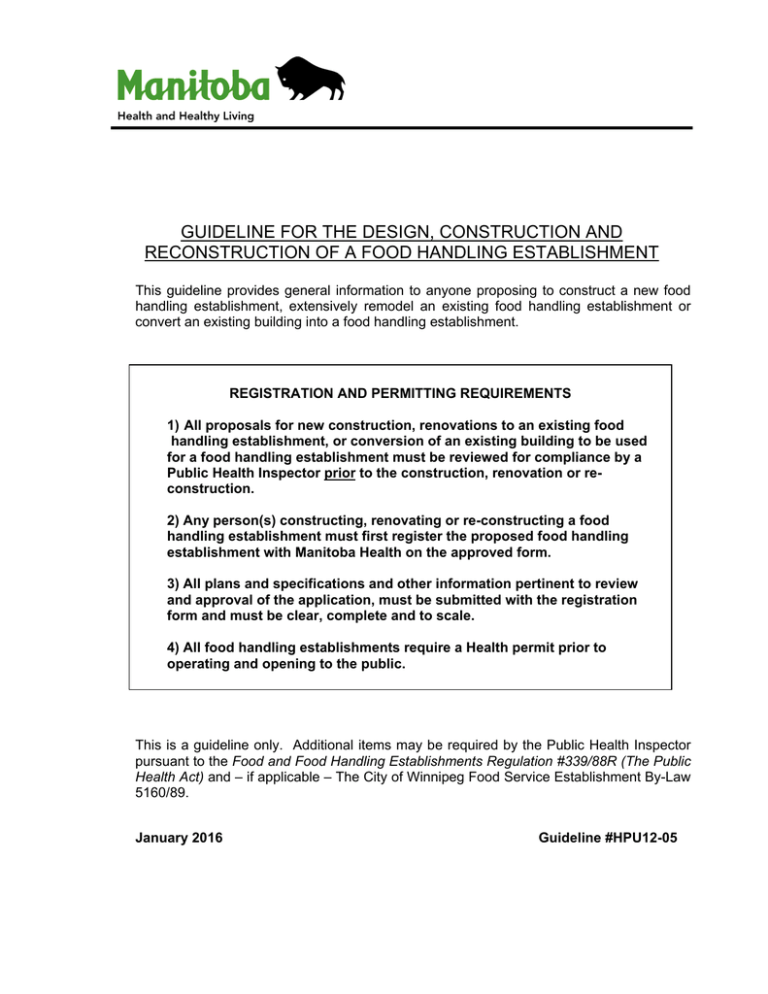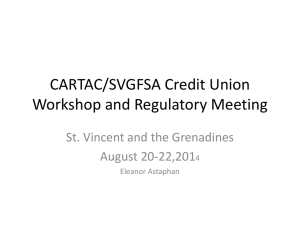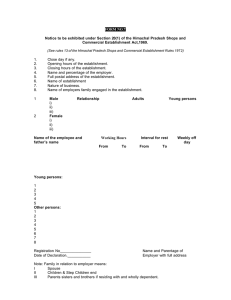guideline for the design, construction and reconstruction
advertisement

GUIDELINE FOR THE DESIGN, CONSTRUCTION AND
RECONSTRUCTION OF A FOOD HANDLING ESTABLISHMENT
This guideline provides general information to anyone proposing to construct a new food
handling establishment, extensively remodel an existing food handling establishment or
convert an existing building into a food handling establishment.
REGISTRATION AND PERMITTING REQUIREMENTS
1) All proposals for new construction, renovations to an existing food
handling establishment, or conversion of an existing building to be used
for a food handling establishment must be reviewed for compliance by a
Public Health Inspector prior to the construction, renovation or reconstruction.
2) Any person(s) constructing, renovating or re-constructing a food
handling establishment must first register the proposed food handling
establishment with Manitoba Health on the approved form.
3) All plans and specifications and other information pertinent to review
and approval of the application, must be submitted with the registration
form and must be clear, complete and to scale.
4) All food handling establishments require a Health permit prior to
operating and opening to the public.
This is a guideline only. Additional items may be required by the Public Health Inspector
pursuant to the Food and Food Handling Establishments Regulation #339/88R (The Public
Health Act) and – if applicable – The City of Winnipeg Food Service Establishment By-Law
5160/89.
January 2016
Guideline #HPU12-05
DEFINITIONS:
“Food Handling Establishment”: includes a food service establishment, retail food store… or
any place, premises, structure or vehicle in which food is: (a) manufactured, processed,
prepared, packaged, stored or handled, or (b) sold or offered for sale, but does not include a
private dwelling in which food is prepared or served for the consumption by the occupant or his
or her family, staff or guests. [M.R. 339/88R]
“Extensively Remodel”: applies to any renovations to an existing operating food handling
establishment that will change the structural and equipment layout and/or will involve
demolition work to walls, ceilings and floors anywhere on the premises.
Procedure for Obtaining Approval and Permit to Operate a Food Handling Establishment
Prior to commencing construction/renovation or conversion, the owner/operator must
submit a completed registration form (attached) to the local Public Health Inspector for
review and approval.
The registration form must be accompanied with a clear and complete detailed drawing
or plan that is to scale, with the information listed below as well as any other
information that may be pertinent to the review of the proposal:
- layout plan showing food preparation, processing, storage, handling, dining,
staff areas and washrooms facilities
- the plans shall show where all of the equipment and plumbing fixtures are
located and include a detailed schedule or specifications sheet
- A list of finishing materials used on walls, floors, ceilings shall be included
- A proposed menu and hours of operation
The registration form must also include a schedule indicating the projected dates for
commencement and completion of: construction and/or reconstruction of the structure;
interior finishing and equipment installation as well as the expected opening date.
The plans will be reviewed by the Public Health Inspector to ensure that regulatory
requirements can be met.
Upon completion of the review the Public Health Inspector will notify the
owner/operator of any non-compliance issues or concerns with the proposal, or advise
that construction of the food handling establishment can proceed as proposed.
Notes: If there is to be a change in construction plans from what was originally
submitted, before or during construction or renovation, it is the owner/operator’s
responsibility to contact the Public Health Inspector prior to making the changes, and
provide a new design plan for review and approval showing the proposed changes.
It is the responsibility of the owner/operator to keep the Public Health Inspector
informed of when the food handling establishment is expected to be ready for
inspection and give at least 5 working days notice for an “opening” inspection.
A permit will only be issued after an inspection has been carried out and all
construction is complete and regulatory requirements are met.
For construction, renovation or conversion of food handling establishments within the
City of Winnipeg, all plans and specifications must be submitted to the City’s One Stop
Plan Approval office located at Unit 31 – 30 Fort Street.
2
CONSTRUCTION REQUIREMENTS
1. STRUCTURE
(i) BUILDING
The building must be of sound construction and of an adequate size to accommodate
the equipment, food and food related products and the various activities involved with
operating a food handling establishment.
All exterior doors and windows must be tight fitting (preferably self-closing) and
capable of restricting the entrance of insects and rodents.
If the food handling establishment will utilize below grade occupancy for any food
preparation or processing activities or food storage, there may be additional
requirements by the Public Health Inspector. Contact your Public Health Inspector for
further information.
(ii) FLOORS
Floors and floor coverings of all food preparation areas, food storage areas, equipment
and utensil washing areas and walk-in-refrigeration units shall be constructed of
smooth, impervious and durable material which is either seamless or with seams that
are heat-sealed or chemically bonded.
Floor coverings in food preparation areas, equipment and utensil washing areas must
be coved and sealed at all floor and wall junctions to a height of 10cms (4 inches).
All floors in washrooms must be made of impervious durable materials and wall and
floor junctions coved and sealed.
List of Approved Floor Coverings
Vinyl Tiles Quarry Tiles Sealed
Concrete
Kitchen
Dishwashing
Dry storage
Serving Area
Washrooms
Walk-in
refrigerators
X
X
X
X
X
X
X
X
X
Poured
Seamless
Commercial
Sheet Vinyl
(seamless)
X
X
X
X
X
X
X
X
X
X
X
X
X
X
3
Examples of Acceptable Coving Installations:
(filleting strip)
{
10 cms
(4”)
Note: In rural or remote areas where professional installation & repair services are not
available, consideration can be given to alternative flooring & coving methods. All coving
seams must be sealed and protected against the entry of: moisture, dirt and pests.
(iii) WALLS, PARTITIONS and CEILINGS
All walls and partitions in food preparation areas, equipment and utensils washing
areas and walk-in refrigeration units must be of a smooth non-absorbent finish and
easily cleanable and durable for the purpose intended.
Studs, joists and rafters in food preparation areas, equipment and utensil washing
areas and walk-in refrigeration units must be covered and not exposed.
Ceilings in all food preparation, equipment and utensil washing areas must be of a
smooth non-absorbent finish and easy to clean. Where a T-bar ceiling is used the
inserts must be non-perforated and plastic coated or have another finish that is nonabsorbent and washable.
All finishing materials should be of commercial grade quality.
4
Examples of Approved Wall Surfaces
Glazed
Surface
Kitchen cooking area
Kitchen – food
prep area
Dishwashing
Dry storage
Serving
Washrooms
Walk-in
refrigerator
Concrete
Filled Epoxy
Paint
Drywall with
Epoxy Paint
Plastic/
Fiberglass
Wall Panels
Stainless
Steel or
Aluminum
X
X
X
X
X
X
X
X
X
X
X
X
X
X
X
X
X
X
X
X
X
X
X
X
X
X
X
X
X
X
(iv) SEPARATION REQUIREMENTS
In accordance with Section 32 of the regulation, where a food establishment is an
extension of a private dwelling or abuts to a private dwelling, it must be designed to
ensure full separation between the business operation and private life.
A separate entrance to the business operation is required. The space must be given a
unique suite number as part its legal address. (i.e. if the civic address is 123 Main
Street, the address sign posted at the business entrance should read “123-A Main
Street” or “#2-123 Main Street”.)
The business space and the dwelling must be physically separated by a solid wall or
full door. The door must be equipped with a self-closing mechanism that must not be
circumvented or propped open at any time.
Unless otherwise approved, all food, storage, processing and cooking facilities must be
separate from those of the private dwelling. No person shall use the business space
for sleeping purposes or allow unauthorized persons or animals to enter the food
operation.
2. EQUIPMENT DESIGN AND INSTALLATION
All kitchen equipment must be of commercial grade quality and preferably certified
(listed) by NSF International (NSF).
Equipment not NSF certified may be subject to approval by a Public Health Inspector
prior to use, to ensure it is suitable for the purpose intended.
It is recommended that heavy and/or large food equipment that is not readily moveable
be mounted on wheels wherever possible.
Equipment that is not mounted on wheels and not readily moveable, must be sealed to
the floor or mounted on legs providing a minimum height of 15 cm (6 inches) from the
floor and located such that access can be gained to all sides of the equipment for
cleaning purposes.
All table or countertop mounted equipment that is not readily moveable and is not
sealed directly to the table or countertop, must be set on legs allowing a minimum of 10
cm (4 inches) of space between the piece of equipment and the table or countertop.
5
A minimum of 91 cm (36 inches) of unobstructed functional space is required for
walkways, whereas a minimum of 107-123 cm (42-48 inches) is recommended for
work aisles.
3. SINKS
Handwash Basins:
A minimum of one separate handwash basin with hot and cold water is required to be
conveniently located in the food preparation area, and depending on the size of the
kitchen and location of food preparation areas within the kitchen, additional handwash
basins may be required.
A handwash basin in a washroom cannot be considered as a designated handwash
basin for a given food preparation area.
The handwash basin must be equipped with a mixing valve or combination faucet.
A liquid soap dispenser and a single use towel dispenser are provided at the handwash
basin.
Dishwashing:
A stainless steel three-compartment sink of sufficient size to adequately clean and
sanitize each utensil (tableware, pots, pans, etc) is required, unless otherwise
approved by a Public Health Inspector.
The dishwashing area must be designed such that there is sufficient space for:
handling dirty and clean utensils; maintaining an adequate separation distance to
prevent them from coming in contact with each other and ensuring the work flow is
uninterrupted and goes from soiled dishes to clean dishes.
Dish tables and/or drain boards or racks are required and must be: non-corrodible; selfdraining; and of sufficient size and numbers for the handling of soiled and clean
utensils as well as air-drying of clean utensils.
Where a mechanical dishwasher is to be used, it must be of commercial grade and
NSF International certified (or equivalent) and approved by a Public Health Inspector.
Properly sized grease traps or interceptors, servicing utensil washing sinks, must meet
the Manitoba Plumbing Code and located such that they are accessible for easy
cleaning and maintenance.
Examples of Dishwashing Areas:
Figure 1: Manual 3-sink configuration flowing from dirty to clean. Sink equipped with “dirty” dish
sorting area and “clean” dish air-drying area.
6
Figure 2: Dishwashing configuration with both manual and mechanical components integrated
so that work flow is uninterrupted from “dirty to clean”.
Janitorial Sink
A separate janitorial style sink is recommended for filling cleaning pails and disposing
of cleaning wastes to prevent contamination of food and dishwashing areas.
4. STORAGE SPACE
Adequate storage space is required and must be provided to ensure that food products
are protected from contamination at all times.
Sufficient refrigerator and freezer space must be provided such that potentially
hazardous foods required to meet menu demands at peak times, are able to be rapidly
cooled and properly stored.
Placement of refrigeration equipment should be carefully considered to ensure that
refrigeration space is available and conveniently located near food preparation areas;
and not affected by extreme heat sources such as ovens, grills and deep fryers.
Storage space must be provided to allow for the storage and separation of items that
are distinct from each other such as food products, equipment and cleaning supplies.
Adequate storage facilities such as lockers or change rooms should be provided for
wearing apparel and other personal items of employees.
It is also recommended that an area be set aside for the storage of unused items.
Shelves to be used for the storage of food and food containers and that are not easily
moveable such as dollies, racks or pallets, must be sealed directly to the floor such that
food particles, dust or debris cannot get under the bottom shelf, or have a minimum
height of 15 cm (6 inches) between the bottom shelf and the floor.
Storage shelving, dunnage racks, dollies and pallets that are not smooth and easily
cleanable are not recommended in food preparation areas and may be prohibited
in some areas of the food handling establishment.
7
5. VENTILATION and EXHAUST SYSTEM
The operational processes of washing, cooking, dishwashing can impact sanitation,
structure and indoor air quality. The menu, type of equipment, layout and size of the
operation dictate the ventilation needed to control these impacts. The Public Health
Act, Manitoba Building Code, The Fire Code and The Workplace Safety & Health Act
are the key pieces of legislation that dictate building ventilation requirements.
As a minimum standard, all food handling establishments using residential cooking
equipment shall be equipped with a Type 2 exhaust hood that is directly vented to the
outside and installed in accordance with the manufacturer’s instructions.
The exhaust ventilation must be located in a manner that will be effective in removing
excess moisture, odours and grease-laden vapours (i.e. located directly over the
cooking appliances or warewashing equipment).
Examples of Type 2 Exhaust Hoods:
Figure 3: Type 2 exhaust with ductwork (A-E) venting to the exterior.
If residential cooking equipment is to be used in a manner that will produce greaseladen vapours that are substantially more than would be expected in a normal
residential environment (i.e. menu involving frying & grilling), the ventilation system
shall meet Type 1 system requirements.
In food handling establishments using commercial cooking equipment, the proponent
shall consult with the local authority having jurisdiction to propose and determine what
Type 1 exhaust ventilation and fire suppression systems are needed to meet the
requirements of: the Building Code, the Fire Code and NFPA 96 “Ventilation Control &
Fire Protection of Commercial Cooking Operations”.
8
Examples of Type 1 Exhaust Hoods:
“Ventless” cooking appliances such as self-contained fryers that have been tested and
listed for ventless operation do not require Type 1 hood systems provided they meet
NFPA 96 standards and are accepted by the authority having jurisdiction. The
appliance shall be used in accordance with the manufacturer’s recommendations.
However, the areas where these system are installed must still be equipped with
proper and effective ventilation to meet minimum indoor air quality standards and
prevent accumulations of cooking residues (i.e. Type 2).
Written confirmation shall be obtained from the authority having jurisdiction indicating
that the ventilation proposal meets regulatory code requirements.
6. LIGHTING
Bright and direct lighting is required in all food preparation areas and dishwashing
areas. A minimum of 215 lx (20 foot candles) is required on all work surfaces in these
areas. A minimum of 540 lx (50 foot candles) is recommended.
Storage areas, washrooms and dinning areas must be provided with sufficient lighting
fixtures to allow for proper cleaning operations. A minimum of 215 lx (20 foot candles)
is required at a distance of 76 cm (30in) from the floor.
All lighting in food preparation areas, dishwashing areas, food and food equipment
storage areas and food display areas must be shielded to protect them from shattering
and protect food and equipment from broken glass.
Note: Shatter-proof bulbs or shatter-proof fluorescent tubes may be
used in place of shields where appropriate.
9
7. WASHROOM FACILITIES
Toilet and handwashing facilities must be provided for staff and must be located in
a convenient location.
Toilet facilities, meeting the requirements of the Manitoba Building Code and
approved by the local authority having jurisdiction, must be provided for patrons.
The following table outlines the minimum number of water closets required for each
gender in new or re-constructed assembly occupancies, as indicated in Table
3.7.2.2.A of the 2010 National Building Code, as adopted by Manitoba:
Number of Persons of
Each Sex
1 - 25
26 - 50
51 - 75
76 - 100
101 - 125
126 - 150
151 - 175
176 - 200
201 - 250
251 - 300
301 - 350
351 - 400
Over 400
Minimum Number of Water Closets
Male
1
1
2
2
3
3
4
4
5
5
6
6
Female
1
2
3
4
5
6
7
8
9
10
11
12
7 + 1 for each additional
increment of 200 males in
excess of 400
13 + 1 for each additional
increment of 100 females in excess
of 400
Note: both sexes are permitted to be served by a single water closet if the
occupant load is not more than 10.
A Public Health Inspector may specify a maximum seating limitation in the
operating permit where washroom facilities do not meet minimum requirements of
the Building Code.
Urinals are permitted to be substituted for two thirds of the number of water closets
required in the above noted Table for males, except that if only 2 water closets are
required for males, one urinal is permitted to be substituted for one of the water
closets.
8. GARBAGE FACILITIES
Garbage containers or facilities must be provided inside and outside the
establishment.
The containers or facilities must be durable, easily cleanable, rodent proof and
must be provided in sufficient numbers and located at convenient locations both
inside and outside.
10
9. POTABLE WATER SOURCE
Where a Food Handling Establishment is not serviced by a licensed Municipal
Water Supply, the water supply system must comply with Manitoba Regulation
40/2007, Drinking Water Safety Regulation, under The Drinking Water Safety Act
and meet all requirements for a semi-public water system.
10. SEWAGE DISPOSAL
The food handling establishment must be hooked up to a municipal sewer system
or other wastewater treatment system licensed under The Environment Act or
serviced by a onsite wastewater system that is of adequate size to receive and
treat all wastewater generated at peak operating times
The system must also be in compliance with the Onsite Wastewater Management
Regulation under The Environment Act.
11. INSECTS & RODENT CONTROL
All outer openings are to be screened or have other adequate controls (i.e. proper
application of air current devices).
All outer doors must be equipped with self-closing mechanisms and tight fitting.
12. OUTDOOR PATIOS
Food and drink preparation is not permitted outside of the permitted establishment.
For further information on outdoor cooking areas, refer to departmental Guideline
#15-01 entitled “Guidelines for the Establishment and Operation of Outdoor
Cooking Operations at a Food Service Establishment”.
11


